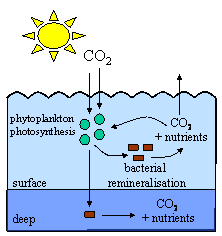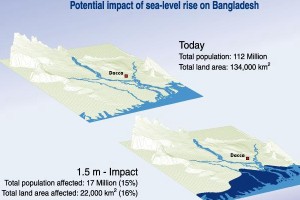|
|
 |
|
|
|
 |
 |
The Oceans
Water covers about 71% of the Earth's surface, all continents together make up for less than one third. Consequently the oceans are of extraordinary importance for our climate.
The key roles of the oceans are:
a) They absorb and reflect sun light.
b) They store the heat
c) They transport the stored heat
d) They cause major changes in the climate system
e) They are the main source of atmospheric water vapour
f) They exchange gases (e.g. CO2) with the atmosphere
|
 |
 |
 |
|
Encyclopaedia Link to topic Oceans
|
|
Oceans as absorber of light and heat reservoirs
Since the Earth receives all energy from the Sun, it is very important for our climate, what happens to the radiation. From own experiences we know that we are for example dazzled by the snow. Ice and snow reflect a major part of the sunlight and appear in light (white) 'colours'. From the black sheet plates of a car we know that it can become rather hot in summer. It absorbs the light and appears in a dark colour, just black. If we have a look on the Earth from the space, we see the same phenomena.
|
 |
 |
 |
|
1. The oceans are driving factors in our climate system © freefoto.com
|
|
 |
 |
|
2. The Earth from space
source: NASA
|
|
 |
The ice caps of the poles appear in white [3], and also the big deserts [2] in light colours. The oceans and the rain forests [1] are dark. The oceans reflect only about 6% of the sunlight. If you take into account that on a global average about 30% is reflected (the Earth albedo) it becomes clear, that most of the energy from the sun is taken up by the oceans.
If you go to the Mediterranean sea in May or September, you may experience rather agreeable warm days with 24 - 28 °C. However, if you go for a bath, in May the sea is still cold after the long winter, while in September warm and pleasurable for bathing. We learn: Although the air temperature is the same, the sea changes its temperature much more slowly than the land does. Oceans are big heat reservoirs.
|
Ocean currents influence local climate
Locations of the same geographical latitude are irridiated in the same way by the Sun. But this does not mean that the climate is comparable, because the land may receive more or less heat depending on the transport of energy by the oceans. Moscow as Hamburg are located between the 53. and 56. degree of latitude. However the winters in Moscow are by far colder than in Hamburg. In the East of the American continent you hardly will find big villages in such regions, since it is too cold. Chilly winters with blizzards and lots of snow happen in Chicago, Toronto and Montreal between 42. and 46. degree of latitude. In Europe you will find there towns as Barcelona, Nice and Rom, that very seldom experience snow at all.
|
 |
 |
 |
|
3. The global ocean circulation
Warm and cold ocean currents are transporting the water masses around the world, on the surface as well as on the buttom of the ocean. The image shows the most important streams.
Source: adapted from W.Broecker (by E.Maier-Reimer) - MPI Hamburg
please click to enlarge (50 K)
|
|
|
The mild European climate is thanks to the gulf stream, an ocean current which conveys warm water from the gulf of Mexico to Europe. At the same time the Newfoundland stream directs the cold water from polar regions to the East coast of North America. In this way the ocean defines the regional climate.
|
 |
 |
|
4. The cycle of CO2 uptake by phytoplankton and CO2 release by bacteria during the so called remineralisation leads to a CO2 storage if bacteria sink to the deep sea.
Scheme: Lucinda Spokes
|
|
 |
Uptake of carbon dioxide
We would have by far more carbon dioxide in the air, if the oceans would not take up about one third of what human beings produce. Carbon dioxides easily dissolves in water, because it is a polar molecule and can also react with carbonate by forming hydrogen carbonate. Additionally the phytoplankton, tiny plants which live in enormous amounts in the oceans take up carbon dioxide in their lifecycle. Some of the CO2 is released again to the atmosphere when phytoplankton dies and bacteria eat it up. We call this process remineralisation. While photosynthesis leads to the formation of biomass, remineralisation leads to its destruction. Sometimes the bacteria sink into the deep sea and remineralisation takes place there. Here, the carbon can be stored as carbonate sediments for hundreds of years.
|
 |
 |
|
5. Phytoplankton: Phaeocystis globosa
© Wim van Egmond
|
|
 |
The role of phytoplankton
The important role of phytoplankton (algae) in the oceans is often underestimated. They do not only take up CO2. If we release too many nutrients into the sea, in particular phosphate and nitrate in the coastal regions, where many people live, we cause a so called eutrophication (over-fertilization).
Floods of phytoplankton form. If bacteria eat it up, oxygen is consumed and the more phytoplankton was in the sea, the more oxygen is missing. Fishes can die. Phytoplankton releases also gases to the atmosphere. One of them is dimethyl sulfide DMS. Its oxidation leads to sulphate particles and sulphate particles lead to the formation of clouds over the ocean. You will see in the topic oceans, that even more gases are formed by plants in the sea, which are important for the climate system.
|
Sea level rise
When climate change and oceans are mentioned, we often think about sea level rise. We are worrying that big parts of the land could be flooded. Present estimations say, that the sea level will rise less than 1 m in the next hundred years. This is a danger only for a few regions in Europe, but for example large parts of Bangladesh could be flooded and millions of people be affected. Also the rich fauna and flora of coral reefs would be lost. It is often thought, that the melting of the polar ice caps due to global warming is the main reason for sea level rise. This is not true. The warming of the air leads to a warming of the oceans and warm water increases in volume. This expansion in volume is the main contributor. Also the melting of inland glaciers contributes, not only the melting of the polar ice. In particular Antarctic ice will not melt so soon.
|
 |
 |
 |
|
6. Bangladesh is one of the countries most endangered by sea level rise. The profile shows the seize of the flooded area for a 1.5 m higher sea level.
source: UNEP GRID
 http://www.grida.no/climate/vital/33.htm http://www.grida.no/climate/vital/33.htm
Please click to enlarge! (40 K)
|
|
|
The topic OCEANS of the climate encyclopaedia explains, how the properties of water and the big ocean streams determine the regional weather on our planet, how phytoplankton living in the sea is involved in gas exchange with the atmosphere and which impact changes in the oceans can have for our climate system.
About this page:
author: Dr. Elmar Uherek - MPI for chemistry, Mainz
last published: 2004-06-11
|
|
 |
|









